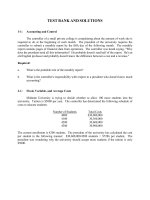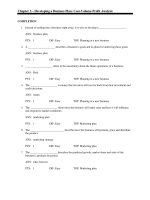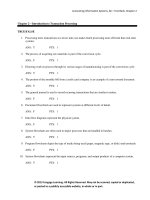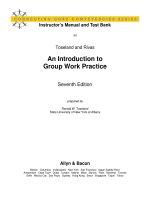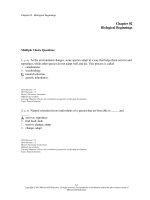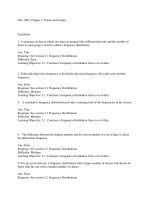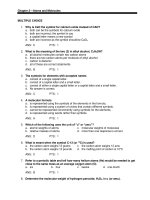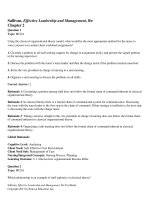Essentials for nursing practice 8th edition potter test bank
Bạn đang xem bản rút gọn của tài liệu. Xem và tải ngay bản đầy đủ của tài liệu tại đây (817.56 KB, 14 trang )
2
Lesson Plan for
Health and Wellness
OBJECTIVES
1.
2.
Identify factors that commonly influence urinary elimination.
Discuss the health belief, health promotion, basic human needs, and holistic health models of
health and illness to understand the relationship between patients’ attitudes toward health and
health practices.
Describe the variables influencing health beliefs and health practices.
Describe health promotion and illness prevention activities.
Explain the three levels of prevention.
Discuss four types of risk factors and the process of risk factor modification.
Describe the variables influencing illness behavior.
Explain the impact of illness on the patient and family.
Discuss the nurse’s role in health and illness.
3.
4.
5.
6.
7.
8.
9.
TEACHING FOCUS
Students need to understand that some conditions of health lie between disease and good
health. Health needs to be viewed in a broader perspective. Various models of health can illness
can be used to understand and explain these concepts.
KEY TERMS
Active strategies of health promotion,
p. 20
Acute illness, p. 24
Chronic illness, p. 24
Health, p. 15
Health belief model, p. 16
Health beliefs, p. 16
Health promotion, p. 20
Health promotion model, p.17
Holistic health, p. 19
Illness, p. 24
Illness behavior, p. 24
Illness prevention, p. 20
Maslow’s hierarchy of needs, p. 17
Passive strategies of health promotion,
p. 20
Primary prevention, p. 21
Risk factor, p. 21
Secondary prevention, p. 21
Tertiary prevention, p. 21
Wellness education, p. 20
Note: Audio glossary available on Evolve.
NURSING CURRICULUM STANDARDS
QSEN
Patient-Centered Care
o Variables Influencing Health Beliefs and Health Practices, p. 19
o Box 2-2 Care of the Older Adult: Importance of Health Promotion, p. 22
o Risk Factor Modification and Changing Health Behaviors, p. 23
o Impact of Illness on Patient And Family, p. 25
Teamwork and Collaboration
o QSEN Activity: Teamwork and Collaboration, p. 26
Essentials for Nursing Practice, 8e
All items and derived items © 2015, 2011, 2007 by Mosby, Inc., an imprint of Elsevier Inc.
Potter
2 Chapter 2Health and Wellness __________________________________________________
Evidence-Based Practice
o Box 2-3 Evidence-Based Practice, p. 22
CONCEPTS
The following conceptual themes and specific concepts match those presented in Giddens, J. R. (2013).
Concepts for nursing practice. St. Louis: Elsevier. The specific exemplars chosen and listed below for each
concept have been tailored specifically to correspond to Potter, Perry, Stockert, and Hall: Essentials for
Nursing Practice, 8th Edition.
A full Concept-Based Curriculum Map covering the entire book can be found here.
ATTRIBUTES AND RESOURCES
Family Dynamics
o Impact on Family Roles and Family Dynamics, p. 26
PERSONAL PREFERENCES
Culture
o Variables Influencing Health Beliefs and Health Practices, p. 19
o Impact on Self-Concept, p. 25
o Variables Influencing Illness Behavior, p. 24
Motivation
o Basic Human Needs Model, p. 17
o Figure 2-1: Health belief model, p. 17
o Figure 2-3: Maslow’s hierarchy of needs, p. 18
EMOTION
Mood and Affect
o Behavioral and Emotional Changes, p. 25
SEXUALITY AND REPRODUCTION
Reproduction
o Genetic and Physiological Factors, p. 21
ATTRIBUTES AND ROLES OF NURSE
Patient Education
o Box 2-1 Patient Teaching: Encouraging Exercise, p. 21
o Table 2-1 Stages of Behavior Change, p. 23
o Box 2-4 Application of the Stages of Behavior Change Model, p. 23
Health Promotion
o Health Promotion, Wellness, and Illness Prevention, p. 20
o Health Promotion Model, p. 17
o Figure 2-2: Health promotion model, p. 18
o Healthy People Documents, p. 19
o The Three Levels of Prevention, p. 21
o Box 2-2 Care of the Older Adult: Importance of Health Promotion, p. 22
CARE COMPETENCIES
Collaboration
o QSEN Activity: Teamwork and Collaboration, p. 26
Evidence
o Box 2-3 Evidence-Based Practice, p. 22
Essentials for Nursing Practice, 8e
All items and derived items © 2015, 2011, 2007 by Mosby, Inc., an imprint of Elsevier Inc.
Potter
___________________________________________________ Chapter 2Health and Wellness
3
HEALTH CARE DELIVERY
Caregiving
o Impact of Illness on Patient and Family, p. 25
BSN Essentials
Essential III: Scholarship for Evidence-Based Practice
o Box 2-3 Evidence-Based Practice, p. 22
Essential VII: Clinical Prevention and Population Health
o Health Promotion, Wellness, And Illness Prevention, p. 20
Essential IX: Baccalaureate Generalist Nursing Practice
o Definition of Health, p. 15
o Models of Health and Illness, p. 16
o Healthy People Documents, p. 19
o Variables Influencing Health Beliefs and Health Practices, p. 19
o Health Promotion, Wellness, and Illness Prevention, p. 20
o Risk Factors, p. 21
o Illness, p. 24
o Impact of Illness on Patient and Family, p. 25
STUDENT CHAPTER RESOURCES
Chap. 2 READ – Textbook (pp. 15-28)
REVIEW – Evolve Resources
Interactive Learning Activities
Audio Glossary
Key Points - Print
ANSWER – Evolve Resources
Chapter 2, Case Study with Questions
Chapter 2, Review Questions
SG
ANSWER – Study Guide
Chapter 2, Health and Wellness, Questions 1-25
EAQ
ANSWER – Elsevier’s Adaptive Quizzing
Chapter 2, Health and Wellness
EAL
REVIEW – Elsevier’s Adaptive Learning
Chapter 2, Health and Wellness
INSTRUCTOR CHAPTER RESOURCES
Essentials for Nursing Practice, 8e
All items and derived items © 2015, 2011, 2007 by Mosby, Inc., an imprint of Elsevier Inc.
Potter
4 Chapter 2Health and Wellness __________________________________________________
TB
Test Bank
To access the ExamView format, go to the Downloads section.
PPT
PowerPoint Presentations (Chapter 2, Health and Wellness)
IC
ETC.
Image Collection
Figure 2-1 Health belief model.
Figure 2-2 Health promotion model.
Figure 2-3 Maslow’s hierarchy of needs.
Chapter 2: Answer Key to QSEN Activity (below)
Chapter 2: Answer Key to Clinical Decision-Making Exercises (below)
Chapter 2: Answer Key to Review Questions (below)
Essentials for Nursing Practice, 8e
All items and derived items © 2015, 2011, 2007 by Mosby, Inc., an imprint of Elsevier Inc.
Potter
___________________________________________________ Chapter 2Health and Wellness
5
TEACHING STRATEGIES
CONTENT FOCUS
INTRODUCTION
DEFINITION OF
HEALTH
CONTENT HIGHLIGHTS
LEARNING ACTIVITIES
Ask students to reflect on their
upbringing about how they were
taught to behave during illness.
Contrast older definitions of health (the
absence of illness) with newer
descriptions (multidimensional
concept).
Start with a definition of health, such as
the WHO definition. Ask students to
contribute what factors affect an
individual’s ideas of health. Discuss
how conditions of life (e.g.,
socioeconomic variables) define health.
MODELS OF
HEALTH AND
ILLNESS
Health Belief
Model
Health Promotion
Model
Basic Human
Needs Model
Holistic Health
Model
HEALTHY PEOPLE
DOCUMENTS
Define health behaviors and discuss
how health beliefs influence behaviors.
Compare and contrast the four models
presented in the text.
Lead a discussion on the government’s
efforts to encourage health. Describe
some of the differences between
Healthy People 2010 and 2020.
RESOURCES
Discuss: Ask students to
define “health” and
“wellness.”
Discussion Topic:
Describe several risk
factors and how their
modification adds to
health and wellness. Ask
students to discuss other
risk factors for various
disorders.
Activity: Have students
break into small groups
of three to six students
and create their own
definitions of “health”
and “wellness” after
discussion. Compare the
definitions from several
groups as a starting point
for additional discussion.
Discussion Topic: Discuss
how people’s
perceptions of health
may influence whether
they consider themselves
ill. Emphasize
individualized care.
Discussion Topic: Ask
students, “Will one
model lend itself to an
acute care setting more
than another?”
Fig. 2-1
Fig. 2-2
Fig. 2-3
Online Activity: Have
students visit
www.healthypeople.gov,
pick a topic (from the
2020 Topics & Objectives
tab), and present (or
write) a summary of the
2020 objectives for that
Essentials for Nursing Practice, 8e
All items and derived items © 2015, 2011, 2007 by Mosby, Inc., an imprint of Elsevier Inc.
Potter
6 Chapter 2Health and Wellness __________________________________________________
VARIABLES
INFLUENCING
HEALTH BELIEFS
AND HEALTH
PRACTICES
Internal Variables
External Variables
HEALTH
PROMOTION,
WELLNESS, AND
ILLNESS
PREVENTION
The Three Levels of
Prevention
Risk factors
Explain the difference between internal
and external variables. Discuss six
internal and three external variables.
Assist students in identifying the
differences among primary, secondary,
and tertiary prevention. Contrast illness
prevention with wellness education
and health promotion.
Define risk factor. When discussing risk
factors, remember to tie in cultural and
family influences. If possible,
demonstrate the use of a health risk
appraisal form.
Reiterate that risk factor modification,
health promotion, and illness
prevention can be considered wellness
strategies. Define health behavior
changes.
ILLNESS
Acute and Chronic
Illness
Discuss how illness influences a
patient’s functioning and well-being,
and the difference between acute and
chronic illness.
topic.
Activity: Have students
pair off to interview each
other about what
internal and external
factors influence their
own health.
Online Activity: Send
students to
www.healthfinder.gov to
investigate a topic
(Health A-Z). Ask
students to report three
question-and-answer
combinations for a topic
of their choice.
Discussion Topic: Discuss
the difference between
passive and active
strategies of health
promotion.
Discuss modifiable
versus nonmodifiable
risk factors.
Activity: Ask students to
pair off and identify at
least two stumbling
blocks (modifiable risk
factors) to their own
health and together
brainstorm ways to
overcome them.
Large Group Activity:
Quiz show! Divide
students into two
groups. Have them write
the definitions of key
terms from this chapter
as statements. The
opposing team must
create the answer as a
question. For example,
team 1 gives the
definition “this type of
illness is usually
reversible and of short
duration.” Team 2
answers, “What is an
acute illness?” Award
points for correct
answers. Deduct half
Box 2-1
Box 2-2
Box 2-3
Table 2-1
Box 2-4
Essentials for Nursing Practice, 8e
All items and derived items © 2015, 2011, 2007 by Mosby, Inc., an imprint of Elsevier Inc.
Potter
___________________________________________________ Chapter 2Health and Wellness
7
points for responses not
phrased as questions
until all terms have been
defined.
VARIABLES
INFLUENCING
ILLNESS
BEHAVIOR
Internal Variables
External Variables
IMPACT OF
ILLNESS ON
PATIENT AND
FAMILY
Behavioral and
Emotional
Changes
Impact on Body
Image
Impact on SelfConcept
Impact on Family
Roles and Family
Dynamics
Describe illness behaviors and internal
and external variables that influence
illness behaviors.
Discuss how illness impacts the patient
and family unit.
Activity: Have students
pick one type of impact
(behavior and emotional
changes; impact on body
image, self-concept,
family roles or family
dynamics) and one
disease or injury and
then describe how that
disease would impact
that aspect of the patient
or family unit.
Essentials for Nursing Practice, 8e
All items and derived items © 2015, 2011, 2007 by Mosby, Inc., an imprint of Elsevier Inc.
Potter
8 Chapter 2Health and Wellness __________________________________________________
IN-CLASS/ONLINE CASE STUDY
George Mason is a 78-year-old black man who has hypertension and chronic obstructive pulmonary
disease (COPD). He is widowed and lives with his daughter and her husband. He is a retired coal miner
and spends time helping his son-in-law work on cars. He is overweight and smokes one pack of
cigarettes daily. He does not exercise. George’s daughter does not work outside the home and watches
her two grandchildren 3 days a week. George helps with the children. Deanna is a student nurse who is
working at the health fair sponsored by Mr. Mason’s church. Her role is to take vital signs and talk with
the patients who have health concerns. Mr. Mason is there to have his blood pressure checked.
1. Deanna knows that Mr. Mason needs to quit smoking to improve his health. What factors should she
take into consideration that could affect Mr. Mason’s willingness to engage in health promotion
activities? Select all that apply.
A. Socioeconomic status
B. Access to resources
C. Other chronic illnesses
D. Mental and physical health
E. Cognitive status
F. Encouragement by health care providers
G. Age
Answer: A, B, C, D, E, F, G
Rationale: All of the factors listed determine how willing a patient will be toward making changes in
behavior that would promote health. Health promotion is focused on increasing the patient’s level of
well-being. How the patient perceives the need to change behavior is based on several variables.
2. Mr. Mason says to Deanna that he doesn’t see any reason to quit smoking; he already has COPD, so it
wouldn’t do any good. According to the stages of the behavior change model, how should Deanna
respond?
A. You are right, it isn’t that important.
B. It is hard to quit smoking. What things are important to you now? What will be important to you over
the next year?
C. I am going to tell your daughter that you have to quit smoking.
D. Maybe someday you will decide to quit smoking. I hope you do before it is too late.
Answer: B
Rationale: By using the principles of the health change model, Deanna is determining whether Mr.
Mason is interested in change and showing him some of the implications of change.
3. As Deanna is talking with Mr. Mason, he tells her that he figures he will eventually get diabetes
because his father and two brothers had type 2 diabetes. This is considered what type of risk factor?
A. Age
B. Environmental
C. Genetic
D. Lifestyle
Answer: C
Essentials for Nursing Practice, 8e
All items and derived items © 2015, 2011, 2007 by Mosby, Inc., an imprint of Elsevier Inc.
Potter
___________________________________________________ Chapter 2Health and Wellness
9
Rationale: Heredity or genetics predisposes a person to specific illnesses, such as diabetes. Family
history increases the chance for the patient to develop the disease.
4. Deanna is explaining to Mr. Mason that diabetes and COPD are examples of what type of illness?
Answer: Chronic illness
Rationale: A chronic illness persists for longer than 6 months and may increase in severity and then be
better controlled, but it is not a disease that will completely be eliminated.
4. Open your charting system and enter the information you have been provided about Mr. Mason.
Document what has occurred in this scenario.
Essentials for Nursing Practice, 8e
All items and derived items © 2015, 2011, 2007 by Mosby, Inc., an imprint of Elsevier Inc.
Potter
10 Chapter 2Health and Wellness __________________________________________________
CHAPTER 2: ANSWER KEY TO QSEN ACTIVITY
Each person on the interdisciplinary team has a unique background, making him or her a valuable team
member. Cardiac disease is a serious, chronic, and costly disease that requires many different disciplines
to effectively help patients manage their care and prevent complications. Preventing cardiac disease by
managing patients at risk is a wise investment of resources and often covered by insurance. For
example, nurses often function in the role of coordinator, ensuring that all required care is met. The
registered dietitian works with Charlie on his food choices and meal planning; psychologists can help
with motivation and assessing for signs of depression, which is not uncommon in people with chronic
disease and life transitions; and a relaxation therapist can help Charlie learn to manage the stress in his
life.
Essentials for Nursing Practice, 8e
All items and derived items © 2015, 2011, 2007 by Mosby, Inc., an imprint of Elsevier Inc.
Potter
___________________________________________________ Chapter 2Health and Wellness
11
CHAPTER 2: ANSWER KEY TO TEXT CLINICAL DECISION MAKING EXERCISES
Note: Answers to these questions can be found on the Evolve site. Click here.
1. Risk factors: male, infrequent exercise, obesity, eats out frequently, high cholesterol, hypertension.
Further questions: family history, past medical history, 24-hour food recall to better determine dietary
intake, adherence to medications, and any history of smoking.
2. The goal in any questions you ask is to think about the individuality of the patient and what may be
influencing his decisions.
• He may think that, because he has had high cholesterol and hypertension for a while without too
many problems, nothing very serious will happen to him.
• He may think that the potential complications simply will not be problems for him.
• He may have had other relatives with high cholesterol and hypertension who either never suffered
from complications or died from something that he perceived to be unrelated to the disease.
• He may be aware of the seriousness but is overwhelmed with work and household responsibilities.
3. a. He is in the preparation stage.
b. Set a date to begin walking. Maintain a log of minutes walked each day. Start slowly so it will be
enjoyable and Charlie will be able to continue to walk. After the first week of walking, set this goal:
increase minutes walked per week by 15 minutes each week until reaching an average of 30 minutes
every day.
Essentials for Nursing Practice, 8e
All items and derived items © 2015, 2011, 2007 by Mosby, Inc., an imprint of Elsevier Inc.
Potter
12 Chapter 2Health and Wellness __________________________________________________
CHAPTER 2: ANSWER KEY TO REVIEW QUESTIONS
1. Answer: 3. The first component of the health belief model is an individual’s perception of his or her
susceptibility to an illness such as the familial risk for coronary artery disease. (p. 16)
2. Answer: 4. The second level on the hierarchy of needs consists of safety needs, which include
establishing stability and consistency. These psychological needs include the security of a home and a
family. (p. 17)
3. Answer: 2. Secondary prevention includes screening techniques and treating disease, if present, at an
early stage to limit disability by delaying the consequences of advanced disease. (p. 21)
4. Answer: 3. Tertiary prevention occurs when a defect or disability is permanent, irreversible, and
stabilized. It involves minimizing the effects of long-term disease or disability by interventions directed
at preventing complications and deterioration. (p. 21)
5. Answer: 3. Heredity or genetic predisposition to specific illness is a major physical risk factor.
Examples of genetic risk factors include family histories of cancer, heart disease, and kidney disease. (p.
21)
6. Answer: 1. The precontemplation stage is when the patient does not intend to make changes within
the next 6 months, is unaware of the problem, or underestimates it. (p. 23)
7. Answer: 1, 2, 4. External variables influencing a patient’s illness behavior include the visibility of
symptoms, social group, cultural background, economic variables, accessibility of the health care
system, and social support. (p. 25)
8. Answer: 1, 2, 3. A person’s concept of illness depends on the person’s developmental stage. A
person’s degree of anxiety or stress influences health beliefs and practices. The way that families use
health care services generally influences their health practices. Cultural background influences a
person’s beliefs, values, and customs. (pp. 19-20)
9. Answer: Health promotion and health protection. The health promotion and health protection are
components from the health promotion model by Pender. (p. 17)
10. Answer: Risk factor. A risk factor is any situation, habit, environmental condition, physiological
condition, or other variable that increases the vulnerability of an individual or a group to an illness or
accident. The presence of risk factors does not mean that a disease will develop, but risk factors increase
the chances that the individual will experience a particular disease. (p. 21)
Essentials for Nursing Practice, 8e
All items and derived items © 2015, 2011, 2007 by Mosby, Inc., an imprint of Elsevier Inc.
Potter
___________________________________________________ Chapter 2Health and Wellness
13
CHAPTER 2: ANSWER KEY TO POWERPOINT SLIDE CASE STUDY
Slide 10
What hurdles need to be overcome for Jack to adopt a more healthy lifestyle? What could you do as a
nurse to encourage behavior changes?
Jack needs to be taught that a healthy lifestyle can be incorporated into a busy lifestyle. For instance,
the time Jack and his wife spend eating out in restaurants can be spent grocery shopping and cooking
for a lot less money. Also, Jack can get up 30 minutes earlier each day to exercise; he can park his car a
good distance from his office building to encourage walking; and he can take the stairs instead of the
elevator. However, the program won’t work if Jack doesn’t commit to it and isn’t held accountable. Jack
can engage his wife and a friend to be his healthy lifestyle buddies to offer him encouragement and to
help celebrate his milestones of improvement.
Reference: pp. 20-24
Slide 19
What do you think Sally plans to do?
Sally plans to talk with Jack to determine his understanding of diabetes and to evaluate his readiness for
the lifestyle behavior changes needed to manage his health.
What risk factors can you identify that increase Jack’s susceptibility to problems with his diabetes and
other diseases?
Sally should educate Jack on the hazards of a persistent elevated blood glucose level such as infections,
impaired vision, and peripheral vascular disease.
What questions would you ask Jack to determine all of his risk factors?
Sally should ask Jack about current and past signs and symptoms of infection, wounds that are slow to
heal, impaired vision, and changes in perceptions of pain or temperature. Sally should also ask Jack
detailed cardiac assessment questions to determine if there is a family presence of heart disease,
especially since he has heart disease. Social factors such as alcohol and tobacco use should also be
assessed in addition to diet and exercise.
What is the impact of Jack’s disease on his wife?
Jack’s unhealthy lifestyle most likely adversely affects his wife. It is difficult for healthy people to be
around unhealthy people. Additionally, if Jack becomes so ill that he requires daily assistance, this could
negatively impact his wife’s career and psychological well-being.
Reference: pp. 21-24
Slide 20
What outcomes would you design for this encounter?
Example outcomes for Jack are:
1. By the end of the visit, Jack will verbalize two reasons it is helpful for him to stay physically active.
2. By the end of the visit, Jack will verbalize one new strategy for exercise he is willing to try.
3. By the end of the visit, Jack will verbalize a willingness to change his work schedule to allow for daily
exercise.
Essentials for Nursing Practice, 8e
All items and derived items © 2015, 2011, 2007 by Mosby, Inc., an imprint of Elsevier Inc.
Potter
14 Chapter 2Health and Wellness __________________________________________________
Reference: pp. 17
Slide 22
How should Sally respond to the knowledge that Jack is at the contemplation stage?
Sally responds to the knowledge that Jack is in the contemplation stage by:
1. Sally targets her teaching to helping Jack see the benefits of exercise, how it could fit into his
schedule, and what kinds of things he likes to do.
2. Sally asks Jack to bring a list of benefits of exercise for him and three or four options for exercise to
their next appointment.
3. With this process, Sally hopes to move Jack into the preparation stage of behavior change for exercise
at their next visit.
Reference: pp. 23-24
Slide 23
What are some additional teaching strategies Sally could use? Then discuss the ones below.
Some additional teaching strategies to use when talking with Jack include:
1. Reinforce the process of change with Jack.
2. Use written resources at an appropriate reading level.
3. Include Jack’s wife to support the lifestyle change.
4. Identify community resources available to Jack (walking track, fitness facilities, etc.).
Reference: p. 21
Slide 27
Which stage (of the stages of behavior model) best describes Jack’s desire to change?
Jack is at the preparation stage.
What goals could Sally help Jack set during this visit?
The goals Sally could help Jack set are:
1. Purchase new walking shoes.
2. While on vacation, walk 30 minutes each day with his wife.
3. Upon return to work, walk 30 minutes each day and log activity.
Reference: pp. 23-24
Slide 28
What other important step can you take as a nurse once Jack begins exercising?
Discuss the value of positive reinforcement.
Reference: p. 21
Essentials for Nursing Practice, 8e
All items and derived items © 2015, 2011, 2007 by Mosby, Inc., an imprint of Elsevier Inc.
Potter
